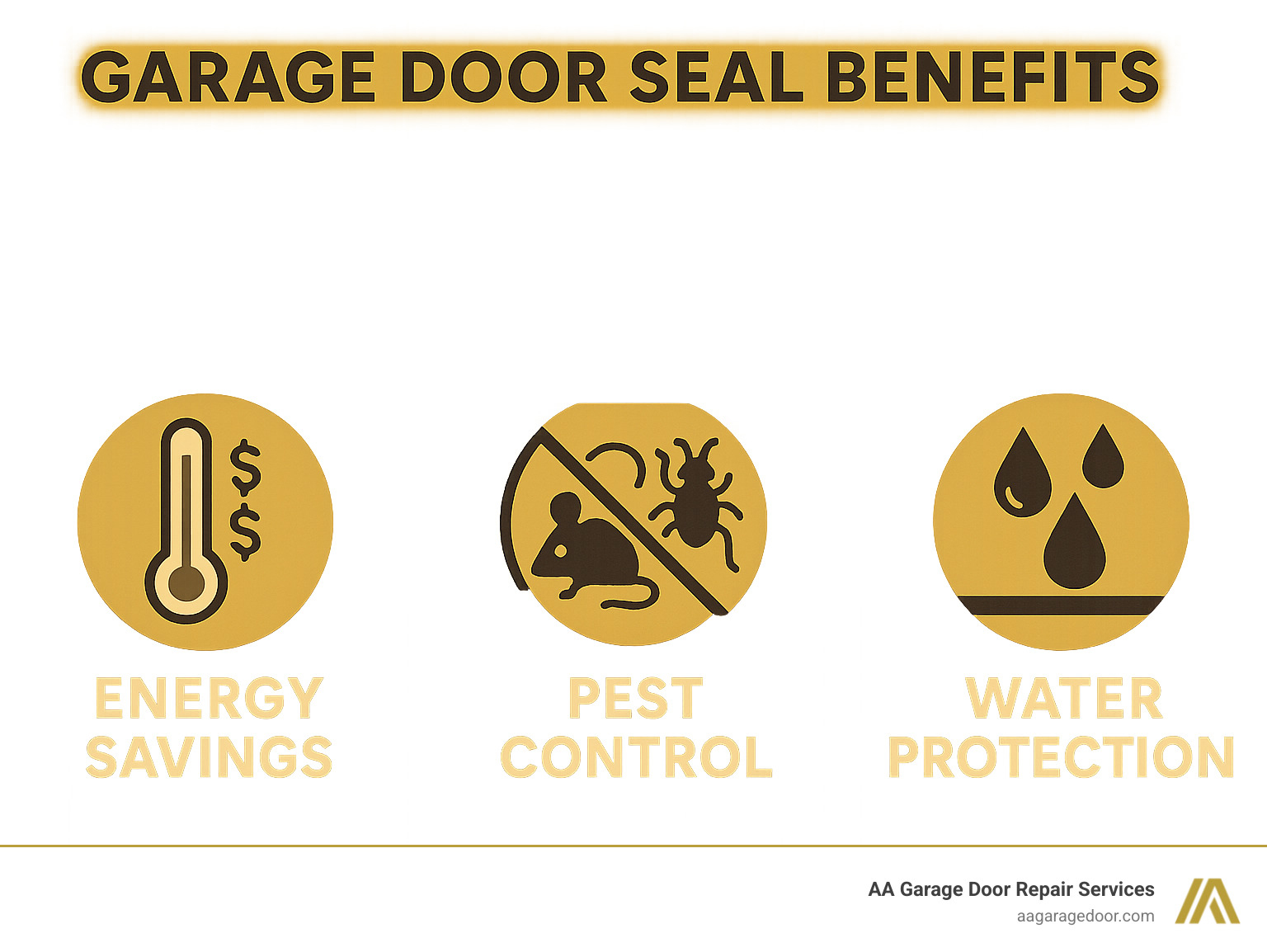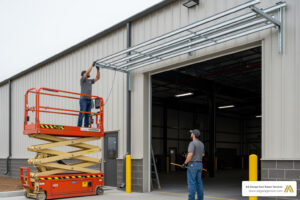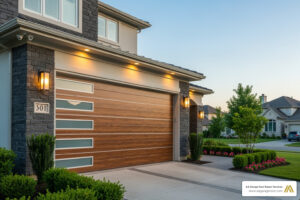Why a Good Garage Door Seal Matters
Garage door rubber replacement is one of the most cost-effective ways to protect your garage. A quality garage door system is essential, as a worn-out bottom seal can let in rain, snow, mice, and cold air, turning your garage into an expensive problem zone. It blocks water, keeps out dust, and creates a barrier against pests. When the seal fails, you’ll notice daylight peeking under your closed door—a clear sign it’s time for replacement.
Quick Answer for Garage Door Rubber Replacement:
- Best Overall: T-Style EPDM rubber seal ($18-$50)
- Installation Time: 15-30 minutes
- Tools Needed: Pliers, utility knife, dish soap
- Lifespan: 2-3 years
- Professional Cost: $100-$200 vs $20-$50 DIY
The benefits of a fresh seal are immediate: lower energy bills, dry floors, no more pests, and reduced dust. A quality garage door starts with proper weatherproofing.
I’m David Sands, owner of AA Garage Door LLC, and I’ve been handling garage door rubber replacement projects across Wisconsin and Minnesota for over 23 years. From emergency repairs to routine maintenance, I’ve seen how the right seal can transform a problem garage into a protected space.

Top Garage Door Rubber Replacement Seals for 2024
When it comes to garage door rubber replacement, choosing the right product is crucial for long-lasting protection. We’ve seen how different seal types perform in various conditions, and we’re here to share our top picks for 2024. You can typically purchase these seals at major home improvement retailers like Home Depot or Lowe’s, or specialized suppliers like North Shore Commercial Door.
Best Overall: Universal T-Style Rubber Seal
For most modern garage doors, the universal T-Style rubber seal is our go-to recommendation. This type of seal is versatile, durable, and effective.
Why We Love It:
- Material Excellence: Most are made from EPDM rubber, known for outstanding resistance to weathering, UV radiation, and extreme temperatures (-50°F to 350°F). It won’t crack or become brittle in harsh weather.
- Durability & Flexibility: EPDM rubber maintains its flexibility, allowing it to conform to minor floor imperfections and create a tight seal.
- Easy Installation: If your door has a T-style retainer, these seals simply slide in, making it a straightforward DIY project.
We’ve used and recommended the M-D Building Products 2 in. x 16 ft. Black Rubber Replacement for Garage Door Weatherstripping 03749 – The Home Depot for years. It’s an excellent example of a high-quality, universal T-style seal.
Best for Older Doors: Universal Vinyl Seal Kit with Retainer
Older garage doors, especially wooden ones, may lack a standard retainer channel. For these, a universal vinyl seal kit with a new retainer is an ideal solution for garage door rubber replacement.
Why We Love It:
- All-in-One Solution: Kits include a vinyl seal, an aluminum retainer, and screws. You install a brand new track system.
- Versatility: They work well for both wood and metal doors, screwing directly to the bottom of the door.
- Rodent-Proof Options: Some kits offer seals with materials that deter pests from gnawing their way in.
This kit is perfect if the old seal was nailed on or the existing channel is damaged, bringing older doors up to modern standards.
Best for Uneven Concrete: Bulb-Style Seal
Garages with uneven concrete floors present a unique challenge. A bulb-style seal, often called a P-bulb seal, is the best choice for garage door rubber replacement in these situations.
Why We Love It:
- Superior Conformity: The bulb shape compresses and expands to conform to uneven surfaces, ensuring a tight seal across the entire door.
- Excellent Water Barrier: The design creates a robust barrier against water, sweeping it away as the door closes.
- Improved Pest Control: By minimizing gaps, bulb seals significantly reduce entry points for rodents and insects.
We frequently recommend bulb-style seals for homeowners in areas like St. Paul and Minneapolis, where older homes may have uneven garage floors. They provide a reliable, long-term solution and are available in various widths (3-inch to 9-inch) to accommodate any gap.
How to Choose the Right Garage Door Bottom Seal
Choosing the right garage door rubber replacement involves considering your door type, its material, and your climate. Let’s break down the details to ensure you make an informed decision.
Understanding Seal Types and Retainers
Garage door seals come in several common profiles that fit into a metal retainer on the bottom of your door.
Common Seal Profiles:
- T-Style: Has two “T” shaped ends that slide into a double-channel retainer. Common on modern metal doors.
- P-Bulb: Features a bulbous section to seal against the floor and a flat section that slides into a retainer. Ideal for uneven floors.
- J-Type: Has a single “J” shaped end for a single-channel retainer.
- Bead-End: Uses small, circular beads that fit into a narrow channel, often on older doors.
Retainer Types:
The retainer is the aluminum channel holding the seal. Most modern doors use a double-channel retainer for T-style seals. Older wooden doors might have the seal nailed or screwed directly on. If you have this setup, you’ll need a universal kit with a new screw-on retainer.
How to Measure for Your Garage Door Rubber Replacement
Accurate measurements are key to a successful garage door rubber replacement. A seal that’s too short or the wrong shape won’t work.
Here’s what to measure:
- Door Width: Measure the full width of your garage door. Buy a seal that is slightly longer and trim the excess.
- Seal Width (when flat): Measure the width of your old seal when laid flat. This determines how much coverage it provides. A 2-inch thick door might need a 4-inch wide seal.
- Retainer Channel Width: For slide-in seals, measure the width of the channel opening (e.g., 1/4″, 5/16″). This ensures the new seal’s ends will fit.
Pro Tip: Take a small piece of your old seal to the hardware store to match the profile perfectly.
Bottom Seal vs. Threshold Seal: What’s the Difference?
While both seals weatherproof your garage, they are installed in different locations.
- Garage Door Bottom Seal: This is the rubber strip attached to the bottom of your garage door. It moves with the door and creates a seal by compressing against the floor. This is the focus of a garage door rubber replacement.
- Garage Door Threshold Seal: This is a strip of rubber glued directly to the garage floor where the door closes. It acts as a static barrier or mini-dam, providing an extra layer of protection against water, especially if your driveway slopes toward the garage. It’s a great addition to a new bottom seal for maximum weatherproofing.
For a comprehensive look at weatherproofing, check out this guide to weather-sealing a garage door.
Your DIY Guide to Garage Door Rubber Replacement
This straightforward DIY task can save you money while dramatically improving your garage’s protection. It’s one of the most rewarding maintenance tasks you can do yourself.
Safety first! Garage doors are heavy. Disconnect the automatic opener and work with a partner if possible. Never work near the bottom brackets where the high-tension cables are attached.
For more safety tips, check out our Pro Tips for Maintaining and Repairing Your Garage Door.
Tools and Materials You’ll Need
Gathering your tools beforehand makes the project go smoothly.
- New Rubber Seal: Matched to your door’s length and retainer type.
- Pliers or Flathead Screwdriver: To open crimped track ends.
- Utility Knife or Scissors: For trimming the new seal.
- Lubricant: Dish soap and water or silicone spray.
- Safety Gear: Work gloves and safety glasses.
- Cleaning Tools: Stiff brush or shop vac to clean the retainer track.
- Drill (optional): If installing a new retainer system.
Step-by-Step Installation Guide
Ready to get started? Let’s walk through this garage door rubber replacement step by step.
- Remove the Old Seal: Lift the door about three-quarters high. Use pliers to gently open any crimped ends on the retainer channel. Pull the old seal out from one side. If it’s brittle, you may need to cut it into sections to remove it.
- Clean the Track: Use a stiff brush, screwdriver, or shop vac to completely clean out any dirt and debris from the retainer channel. A clean track ensures a proper fit for the new seal.
- Lubricate and Install the New Seal: Liberally apply a lubricant like soapy water or silicone spray to the retainer channels. With a helper, feed the new seal into the track from one end while your partner gently pulls it from the other. Ensure the seal’s bulb or ridge faces outward toward the driveway.
- Trim and Secure: Once the seal is in place, use a utility knife to trim the excess, leaving about half an inch of overhang on each side. If the original retainer was crimped, gently crimp the ends again to hold the new seal in place.
Step back and admire your work! You’ve just given your garage professional-level weather protection for a fraction of the cost.
Frequently Asked Questions about Garage Door Seals
Over 23 years serving homeowners across St. Paul, the Twin Cities, and Western Wisconsin, we’ve answered thousands of questions about garage door seals. Here are some of the most common.
When should I replace my garage door seal?
Your seal will show you when it’s time for a garage door rubber replacement. Look for these clear warning signs:
- Visible Damage: The rubber is cracked, torn, or brittle.
- Flattened Shape: The seal stays compressed and no longer feels flexible.
- Visible Daylight: With the garage door closed, you can see light coming in underneath.
- Water or Pests: You find puddles after rain or signs of pests in the garage.
Most quality seals last 2-3 years, but harsh weather or heavy use can shorten this lifespan. If you see any of these signs, it’s time for a replacement.
What is the average cost of a garage door rubber replacement?
This is a very budget-friendly maintenance task. The cost for garage door rubber replacement depends on whether you do it yourself or hire a professional.
- DIY Cost: Expect to pay $18 to $50 for the seal itself. A standard 16-foot EPDM rubber seal typically costs around $25.
- Professional Installation: This usually runs between $100 and $200, including materials and labor. The price can vary based on location and if a new retainer channel is needed.
The investment pays for itself quickly by preventing costly water damage and pest infestations. For more on garage door costs, see our guide to Garage Door Repair Cost.
Can a new seal stop mice and other pests?
Yes, absolutely. A new bottom seal is one of the most effective ways to stop pests from entering your garage. Mice can squeeze through gaps as small as a quarter-inch, so any space under your door is an open invitation.
A properly installed garage door rubber replacement creates a tight physical barrier against the floor, eliminating the entry points that rodents and insects use. We’ve seen countless homeowners solve persistent pest issues simply by replacing a worn-out seal.
For extra protection in areas with significant pest problems, you can opt for special rodent-proof seals made with tougher materials. For under $50 and an afternoon’s work, you can reclaim your garage from unwanted visitors.
Conclusion: Secure Your Garage with the Right Seal
Your garage door rubber replacement is a straightforward and highly rewarding home improvement. The change is immediate: improved insulation, a drier garage, and an end to unwanted pests and dust. When you close your garage door and know it’s truly sealed, you’ve created a barrier that protects your home and improves its curb appeal.
While this is a manageable DIY project for most, we know life gets busy. Sometimes you’d rather spend your weekend with family than wrestling with a stubborn seal. That’s where AA Garage Door Repair Services comes in. We’ve been helping families in the Twin Cities and Western Wisconsin with these projects since 2001.
If you’re in St. Paul, Minneapolis, Hudson WI, or our surrounding service area and want expert help, we’re just a call away. Our 24/7 emergency service means we’re here when you need us, with transparent pricing and a satisfaction guarantee.
Sometimes, a worn seal is a sign of a larger issue. If we find the damage is more extensive, we’ll provide honest advice on whether it’s time for a full Garage Door Replacement.
Ready to secure your garage? Give us a call at (815) 200-1255. We’re here to help you get the peace of mind that comes with a properly sealed garage door.










